Berlin II: Pergamon, Protestants, and Return
 The Pergamon Museum tour, like that of Gilligan's Minnow, was to be three hours. It turned out to be rather longer for many of us. The Pergamon is too much for just three hours--even on roller blades. Because of the size of of Regensburg group, and because the tour was a class project, admission was free.leaving fund for wireless audio guides for everyone.
The Pergamon Museum tour, like that of Gilligan's Minnow, was to be three hours. It turned out to be rather longer for many of us. The Pergamon is too much for just three hours--even on roller blades. Because of the size of of Regensburg group, and because the tour was a class project, admission was free.leaving fund for wireless audio guides for everyone.At the turn of the 20th century German archeologist were busy beavers. Heinrich Schliemann's excavations at Troy and Mycenea established the historical truth of the stories of Homer and Vergil and soon German scholars were digging up the national treasures Greece and of nations yet to be made from the Ottoman Empire yet to collapse. They collected so much stuff they were running out of room in the Bodemuseum. To hold all the booty the Pergamon was begun in 1909, completed in 1930, damaged during WWII and still shows bullet and shell scars.
The muesuem is named for 2nd Century BCE Pergamon Altar with its 371-foot long sculptural frieze of the war between the gods and the giants (neither a sports team) that is its most important exhibit.

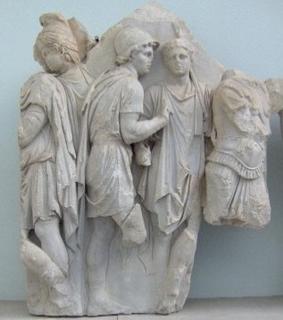
But for my money more amazing is the reconstruction of Babylon’s eigth gate, the Ishtar Gate, built to that goddess by order of King Nebuchadrezzar II in 575 BCE. Its surface is covered by blue glazed tiles on which are depicted dragons and bulls and it leads to a Processional Way with walls covered by 120 lions made of glazed bricks.
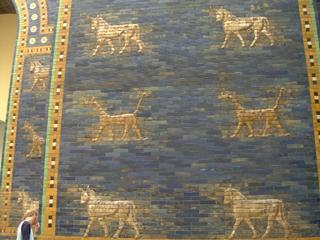
The art of polychromatic glazed brick continued to develop amoung later peoples of the Eastern Mediterraean including Muslims whose art has its own wing in the museum. Below you can see the progression from Babylonian to Persian to Muslim application of this art form.



I found myself taking pictures with my World Civ classes in mind especially the monumental sculptures of the Assyrians and the rock carvings of the mysterious Hittities.



One thing about going through a huge collection like the Pergamon's is that patterns emerge--across cultures and across centuries. I kept seeing design elements that reminded me of a famous piece that was one of those feared lost in the looting of Bagdad's mueuems following the fall of Sadam. Called Goat caught in a Thicket, it was later recovered.
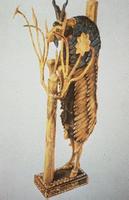
Compare its design to these other pieces--the first Assyrian (7th Century BCE), the second Iranian (7th Century CE ) and the third from a Muslim carpet (15th Century CE). I'm no art historian but this seems to be a trope of that endured for centuries in among sucessive civilizations in the Middle East.



Sunday we left Berlin early in order to have some time at Whittenberg where Martin Luther posted his 95 thesis to the Cathedral door, ended what passed for European unity, and indirectly
 gave rise to a world of nation-states.
gave rise to a world of nation-states.The Catholic Encyclopedia refers to University of Wittenberg then being "in its infancy (founded 2 July, 1502), with an enrolment of one hundred and seventy-nine students. The town itself was a poor insignificant place, with three hundred and fifty-six taxable properties, and accredited the most bibulous town of the most bibulous province Saxony."
Luther was born 1483, the son of a relatively well-off anti-clerical miner and a deeply religious mother. Both were harsh disciplinarians who beat Luther often. Luther was schooled and sent to university to study law and was a brilliant scholar. He became an Augustine monk After being struck by lightening while traveling (think Paul on road to Damascus) he became an Augustinian monk, then a priest, then a professor of theology at Wittenberg University of Saxony in 1508.
Obsessed by questions of sin, forgiveness and salvation he was 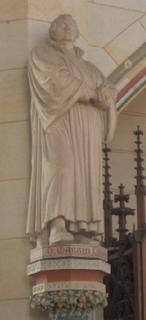 struck by Paul's Epistle to the Romans I:17 "The just shall live by faith." He concluded faith in God freed man from sin, not good works. The ultimate implication was that the structure of the Catholic Church was not needed for salvation. Luther was also influenced by Humanism, the Renaissance philosophical and literary movement that put human values at the center. Humanists emphasized secular studies (the humanities), and classical ideals and forms, rejecting medieval religious authority in favor of scientific knowledge.
struck by Paul's Epistle to the Romans I:17 "The just shall live by faith." He concluded faith in God freed man from sin, not good works. The ultimate implication was that the structure of the Catholic Church was not needed for salvation. Luther was also influenced by Humanism, the Renaissance philosophical and literary movement that put human values at the center. Humanists emphasized secular studies (the humanities), and classical ideals and forms, rejecting medieval religious authority in favor of scientific knowledge.
The issue of salvation crystallized for Luther around the Pope's sale of indulgences to finance the building of St. Peter's in Rome. Indulgences lessen the time that a soul would spend in Purgatory by transferring reserves of goodness (spiritual capital) built up by particularly holy people to sinners in return for a cash payment made to the Church.
 struck by Paul's Epistle to the Romans I:17 "The just shall live by faith." He concluded faith in God freed man from sin, not good works. The ultimate implication was that the structure of the Catholic Church was not needed for salvation. Luther was also influenced by Humanism, the Renaissance philosophical and literary movement that put human values at the center. Humanists emphasized secular studies (the humanities), and classical ideals and forms, rejecting medieval religious authority in favor of scientific knowledge.
struck by Paul's Epistle to the Romans I:17 "The just shall live by faith." He concluded faith in God freed man from sin, not good works. The ultimate implication was that the structure of the Catholic Church was not needed for salvation. Luther was also influenced by Humanism, the Renaissance philosophical and literary movement that put human values at the center. Humanists emphasized secular studies (the humanities), and classical ideals and forms, rejecting medieval religious authority in favor of scientific knowledge.The issue of salvation crystallized for Luther around the Pope's sale of indulgences to finance the building of St. Peter's in Rome. Indulgences lessen the time that a soul would spend in Purgatory by transferring reserves of goodness (spiritual capital) built up by particularly holy people to sinners in return for a cash payment made to the Church.
In 1517, Luther nailed his famous 95 theses to the Cathedral door. It wasn't really as an act of defiance but rather the usual way to announce an academic debate:
Out of love for the truth and the desire to bring it to light, the following propositions will be discussed at Wittenberg, under the presidency of the Reverend Father Martin Luther, Master of Arts and of Sacred Theology, and Lecturer in Ordinary on the same at that place. Wherefore he requests that those who are unable to be present and debate orally with us, may do so by letter. Nothing may be nailed there anymore however; its doors are covered in Brass.


They aroused tremendous discussion. The local bishop saw nothing heretical but advised Luther not to publish any more for a while. But Luther did not lay low. He vigorously answered his critics, fanning the flames by asserted Church councils had authority over the Pope and that the Church had been wrong to condemn John Wycliffe and John Huss as heretics in the late 14th century for teaching that salvation required no Church, only the word of God contained in the Bible.

Politics Surrounding Luther. When Pope Leo X summoned him to Rome, Luther argued to his Prince the Elector Frederick that it was unwise for German princes to allow the Pope to order the extradition of citizens of their kingdoms. HRE Maximilian agrees advising Frederick to "take good care of that monk." At that time, Pope Leo was selling indulgences and trying to tax the German princes to finance a crusade against the Turks. The imperial Diet refused fearing the money would be used for other purposes as in the past and complained that all the good church offices went to Italians. But HRE Max did promise the Pope to deal with Luther, if Pope suspended extradition order. Pope agreed and Luther was summoned before Church authorities at Augsburg.

Politics Surrounding Luther. When Pope Leo X summoned him to Rome, Luther argued to his Prince the Elector Frederick that it was unwise for German princes to allow the Pope to order the extradition of citizens of their kingdoms. HRE Maximilian agrees advising Frederick to "take good care of that monk." At that time, Pope Leo was selling indulgences and trying to tax the German princes to finance a crusade against the Turks. The imperial Diet refused fearing the money would be used for other purposes as in the past and complained that all the good church offices went to Italians. But HRE Max did promise the Pope to deal with Luther, if Pope suspended extradition order. Pope agreed and Luther was summoned before Church authorities at Augsburg.
 Luther refused discipline; Frederick protected him. Pope tried to bribe Frederick to give up Luther (the child of Satan) by offering him the Order of the Golden Rose. Luther persuaded to back off to preserve the unity of Christendom, but then renews his attacks. Denies the superiority of the Clergy to the laity; declares individual interpretation of the Bible to be ultimate authority - not Pope or Church; rejects salvation through good works; fasts, saints etc; rejected existence of purgatory; reduced sacraments to two - baptism and communion (his new name for the mass); repudiated the then "new" doctrine of transubstantiation; calls for marriage for priests and end to monastic orders.
Luther refused discipline; Frederick protected him. Pope tried to bribe Frederick to give up Luther (the child of Satan) by offering him the Order of the Golden Rose. Luther persuaded to back off to preserve the unity of Christendom, but then renews his attacks. Denies the superiority of the Clergy to the laity; declares individual interpretation of the Bible to be ultimate authority - not Pope or Church; rejects salvation through good works; fasts, saints etc; rejected existence of purgatory; reduced sacraments to two - baptism and communion (his new name for the mass); repudiated the then "new" doctrine of transubstantiation; calls for marriage for priests and end to monastic orders. In 1520 Pope Leo issued a Bull of Excommunication. Luther publicly burned it, then issued his Address to the Christian Nobility of the German Nations calling on German princes to assume authority over religion within their own boundaries. Princes respond, eager to gain independence, not only from Rome, but from the new HRE Charles V. Thus in 1521, Charles summoned Luther to the imperial Diet at Worms: "I neither can nor will recant anything since it is neither safe nor right to act against conscience. Here I stand; I can do no other.” Charles put Luther under an imperial ban, a death sentence. But the Elector of Saxony hid Luther in Wartburg castle where Luther translated the Bible into German, considering it absolutely necessary since his defense was the Bible.
Peasant Revolt, 1524-1525. In South West Germany peasants defy their lords; refuse to honor feudal obligations; justify by reference to Bible. Fearing loss of his noble support, Luther repudiates peasants; calls them swine and urges nobles to "drown the revolt in blood" which they do. German prince then assume authority over religion within their borders = church as arm of state, the object of all "new monarchies." This trend firm by Luther's death in 1546, as was his increasing anti-Semitism.
Since the fall of the DDR, Whittenburg has attempted to remaking itself as a tourist Mecca (well, not exactly Mecca, but you get the idea).
That afternoon we were back on the train, all tired puppies headed home.

Well, almost everybody!




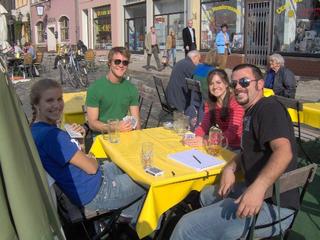






0 Comments:
Post a Comment
<< Home